#like the threat of rising sea level. and bleaching
Note
can you please tell me more about the island at the equator? the one you drew about? i'm planning on becoming a sailor and i want to know what it was like way out there. can you tell me about the stars and the manta rays
I would love to tell you more about that island.
It's a tiny atoll, with a little over 4.6 square miles of permanent land. The hottest sun and most furious rain I've ever seen in my life, often in the same 24 hours. There are no freshwater sources here; everything you drink must come from the sky. Coral reefs surround the lagoons and islands, in vivid terraces that cascade from crystalline shallows to water so deep and blue it confuses your eyes. Sand flats and coral rubble beds stretch around the margins of the lagoons, and sometimes the water is so still and glassy that you can see the ripples from the spotted eagle rays and lemon sharks and schools of awa from a half mile away. Blue bottle jellies come up with high tides every new moon, and the manta rays gather in winding circular trains when the moon is full. Bioluminescent plankton is a rare and treasured guest, making the wave tops glitter cyan and green, illuminating each wingtip on the manta rays as they ruffle the surface of the water. Over one million seabirds make their homes there, and sometimes the chatter of the 'ewa'ewa is so constant and deafening that you stop hearing it at all, fading into the background sounds of wind and water and trees. The 'iwa fly in the highest wind currents, pirates of the sky, with their big forked tails and sharp lightning-bolt wings. The manu-o-Kū catch the tiniest silver fish, the length of my pinky, and flutter down from their perches to chitter at you as you move through the forest. The 'ā - red-footed boobies - crane their heads from side-to-side as they look at you, and when they open their mouths, you remember that birds come from dinosaurs. The stars are close and bright, despite the heavy humidity, and on clear nights the milky way is like a hundred pearl necklaces stretched across the sky, and you can walk with just the light of the moon. You can see the Southern Cross from one side of camp, and Polaris from the other. Cassiopeia sits in pride of place, and her daughter Andromeda is a lightblur in the crook of her knees. Meteors there sometimes fall like brilliant green balls of fire, so bright they put spots in your vision. On nights under one of those big dark storm cells that walk across the ocean like giants, the thunder and lightning moves around you in transient peaks and swells, inconstant, distant and then close. These are the only times you cannot hear the birds, gone silent, as the downpour takes up the place where their voices live.
#there are of course also a million other things i could say. and some are sadder to hear#like the threat of rising sea level. and bleaching#unexploded ordnance from military occupation#invasive species that will still yet take years to fully remove or control#extirpated birds that we are fighting tooth and nail to bring back with minimal success#the inner lagoon corals that were annihilated and are struggling to creep back#but above everything is this; you must press on for what is still there and is beautiful and must hope that it will remain!#sorry this got so long!#beckett.txt#asks#darubyprincx
61 notes
·
View notes
Text
Igor Bobic and Chris D'Angelo at HuffPost:
Former President Donald Trump is more than happy to fulfill the oil and gas industry’s wish list if he’s reelected — but he has an asking price.
Trump reportedly solicited top oil and gas executives to give $1 billion for his campaign to return to the White House, vowing in return to undo many of President Joe Biden’s green energy policies if he is elected in November.
Trump hosted the country’s top fossil fuel CEOs at his Mar-a-Lago club in Florida last month when he “stunned” executives with the ask, according to The Washington Post. The $1 billion sum would ultimately be a “deal” for the fossil fuel industry, Trump reportedly told the executives, because of the money they would save with him in office. An anonymous industry source told the Post that Trump is likely to get some funds.
The oil and fossil fuel industry has long made its alliances with the Republican Party, which generally supports and promotes fossil fuels. Ahead of the 2024 election, the industry has been drawing up “ready-to-sign” executive orders for Trump if he wins the presidency, aimed at expanding natural gas exports and increasing offshore oil leases, Politico reported this week.
A second Trump term would mean a sharp departure from Biden’s agenda of clean energy, electric vehicles and historic efforts to fight climate change. The former president has falsely called global warming a “hoax” and has vowed to unravel Biden’s landmark climate programs included in the Inflation Reduction Act.
Republicans have spent the entirety of Biden’s term condemning what they describe as the administration’s “war” on energy, even though U.S. oil production and exports of natural gas have never been higher. They accuse Biden of being beholden to “radical environmentalists” — an ironic talking point given Trump and the GOP’s unflinching loyalty to the fossil fuel industry.
[...]
Trump appears to be laying the groundwork to quickly implement many of the policy priorities of Project 2025, the sweeping blueprint that right-wing organizations have compiled to guide Trump if he is reelected in November. Certain sections of that pro-Trump memorandum are little more than an oil industry wish list. As HuffPost previously reported, the energy section of the chapter for the Interior Department was authored by Kathleen Sgamma, the president of the Western Energy Alliance, a prominent oil and gas trade association.
Trump’s quid pro quo with the industry comes as the world’s coral reefs are in the midst of a global bleaching event — only the fourth such event on record. Hundreds of climate scientists told The Guardian this week that global temperatures are on track to soar well beyond 1.5 degrees Celsius (2.7 degrees Fahrenheit) above pre-industrial levels, the aspirational goal of the landmark Paris climate accords.
For years, scientists have warned about the disastrous consequences of failing to keep temperatures under the 1.5-degree mark, from rising seas and increasingly extreme weather to famines and severe social and economic disruptions. The fossil fuel industry is most responsible for the crisis and has spent decades denying and downplaying the threat, with the help of industry-allied Republicans.
Donald Trump is in the pocket of Big Oil executives, as he told its magnates he wants $1BN to undo President Joe Biden’s clean energy and green initiatives to instead push the pro-fossil fuels and climate change denialist agenda.
#Donald Trump#Big Oil#Energy#Fossil Fuels#2024 Presidential Election#2024 Elections#Climate Change Denialism#Climate Change#Inflation Reduction Act
10 notes
·
View notes
Text
Understanding Climate Change.
Climate change is one of the most pressing issues facing our planet today, impacting ecosystems, economies, and communities across the globe. It refers to long-term changes in temperature, precipitation, wind patterns, and other elements of the Earth’s climate system. Primarily driven by human activities—particularly the burning of fossil fuels and deforestation—climate change poses significant threats to our way of life and the natural world.
Rising Temperatures and Extreme Weather
One glaring consequence of climate change is the increase in global temperatures. According to the Intergovernmental Panel on Climate Change (IPCC), the Earth’s average surface temperature has risen by approximately 1.2 degrees Celsius since the late 19th century. This seemingly small increase has led to extreme weather events, such as more intense hurricanes, prolonged droughts, and unprecedented heatwaves. The effects of these phenomena are devastating, often resulting in loss of life, damage to infrastructure, and economic hardship.
Melting Ice Caps and Rising Seas
Another alarming impact of climate change is the melting of polar ice caps and glaciers. As temperatures continue to rise, ice sheets in Greenland and Antarctica are shrinking at an accelerating rate, contributing to rising sea levels. This poses an existential threat to coastal communities and island nations, with estimates suggesting that millions of people could be displaced by 2050. The loss of ice also disrupts marine ecosystems, affecting wildlife that relies on ice-covered regions for habitat.
Threats to Biodiversity
Climate change also threatens biodiversity, as many species struggle to adapt to shifting climates. Habitats are changing, and some species are facing extinction. For instance, coral reefs, known as the “rainforests of the sea,” are experiencing widespread bleaching due to warmer ocean temperatures and acidification. The loss of biodiversity undermines the resilience of ecosystems, affecting food security, water supply, and human health.
The Hope for Change
Despite these grim realities, there is hope. A global awakening to the urgent need for action has sparked movements around the world. From grassroots activism to international agreements like the Paris Accord, communities are mobilizing to combat climate change. Transitioning to renewable energy sources, such as wind and solar, improving energy efficiency, and advocating for sustainable practices are essential steps we can take.
Individual Actions Matter
Individuals also play a crucial role in addressing climate change. Simple acts, such as reducing energy consumption, using public transportation, supporting local agriculture, and advocating for policies that protect the environment, contribute to collective efforts. Combating climate change is not just an environmental issue; it’s a moral one that concerns our shared future on this planet.
Conclusion
In conclusion, climate change is an urgent crisis that affects every living being on Earth. By recognizing the signs and understanding the stakes, we can work together to create a sustainable future, ensuring a healthy planet for generations to come. The time for action is now—every effort counts in safeguarding our world.
Blog – My Blog (kesug.com)
0 notes
Text
Should popular destinations limit visitor numbers?

In an era where wanderlust fuels the dreams of millions and Instagram feeds overflow with snapshots from the world’s most popular destinations, the question of whether the number of visitors should be limited still remains unanswered. It is noted that in 2021 alone, there were 448 million tourists travelling across the globe, according to Our World in Data. While the allure of these places is undeniable, drawing visitors in from every corner of the globe, their popularity has also brought a myriad of challenges that threaten their long-term sustainability. In this essay, I will dive into the multifaceted arguments surrounding the need to impose restrictions on tourist numbers at popular attractions.
One of the most undeniable aspects of popular tourist destinations is that they encompass natural wonders and culturally significant sites, that is why they are so attractive for visitors. However, the unrestrained influx often leads to environmental pollution and irreversible damage to fragile ecosystems. For instance, In Thailand, the Maya Bay coral reefs, made famous by Leonardo DiCaprio’s film, The Beach, are being degraded from tourist activities. Tourists often engage in activities such as snorkelling and diving, which, while enjoyable, often contributes to physical damage to the reefs. Additionally, in Hawaii, an insanely prominent tourist destination, the coral reefs have been suffering from the presence of toxic chemicals. The sunscreen used by swimmers contains chemicals like oxybenzone and octinoxate, which even though diluted with sea-water, contribute to coral bleaching and hinder their growth. By limiting the number of tourists visiting these sites, we can alleviate these threats, giving these precious sites an opportunity to recover and thrive.

Secondly, tourism activity can lead to significant disruptions in the lives of local communities, often resulting in displacement. As tourist numbers surge, the demand for accommodation, infrastructure, and transportation services increases. In fact, The United Nations World Tourism Organization (UNWTO) warns that by 2030, transport-related carbon emissions from tourism are projected to increase by 25% from 2016 levels, representing a significant rise from 5% to 5.3% of all man-made emissions. This growth in emissions not only contributes to climate change but also exacerbates the environmental degradation already being experienced in many tourist destinations.
Moreover, the environmental impact of tourism extends beyond carbon emissions. Infrastructure development, such as constructions of roads, airports and hotels often encroaches upon natural habitats and agricultural land, further exacerbating the displacement of local communities. Indigenous people are particularly vulnerable to displacement, as their lands are often targeted for tourism development without adequate consultation or consent.
However, if the number of tourists visiting popular destinations are limited, the consequences could be significant to the economies of many countries heavily reliant on tourism. One country that exemplifies this is Thailand, where tourism plays a vital role in driving economic growth and development. Thailand is heavily reliant on tourism as a major contributor to its GDP. According to data from the World Travel and Tourism Council (WTTC), the tourism industry directly contributes around 20% to Thailand's GDP and accounts for approximately 21% of total employment in the country. The sector encompasses a wide range of businesses, including hotels, restaurants, transportation services, tour operators, and souvenir shops, all of which provide jobs and generate income for millions of people, particularly in rural and coastal areas. Moreover, tourism revenue has helped fund infrastructure development, conservation projects, and cultural preservation initiatives across Thailand. Iconic destinations such as Bangkok, Phuket, and Chiang Mai attract millions of visitors each year, injecting billions of dollars into the economy and supporting countless livelihoods.

Another reason why the number of tourists should not be limited is because of the invaluable cultural exchange and global understanding tourism fosters. For example, cities like New York, Paris, and Tokyo are melting pots of cultural diversity, where tourists can experience a myriad of cultures, cuisines, and traditions. This exposure promotes mutual respect and appreciation among people of different nationalities and ethnicities. Tourists gain firsthand experience of different ways of life, beliefs, and customs, which can challenge stereotypes and reduce prejudices. This cultural exchange enriches the lives of both visitors and locals, fostering a sense of global community and understanding.
Additionally, tourism supports the preservation and promotion of cultural heritage. When tourists visit cultural sites, attend local festivals, or participate in traditional activities, they contribute to the local economy and provide incentives for communities to preserve their cultural practices. This dynamic helps sustain traditional crafts, music, dance, and other cultural expressions that might otherwise be at risk of fading away in a rapidly globalising world. For instance, the city of Kyoto in Japan, with its rich history and numerous UNESCO World Heritage sites, benefits from tourism by preserving its temples, gardens, and traditional tea houses. If we limit the number of tourists in these areas, there will be less revenue generated from tourism which can help fund the maintenance and restoration of these cultural treasures.

In conclusion, the debate over whether to limit tourist numbers at very popular places revolves around principles of preservation, sustainability, and quality of experience. While tourism brings undeniable benefits, it also poses challenges to the environment and culture of destinations. Therefore, it is essential to implement measures to manage tourist numbers effectively, ensuring the long-term viability of monumental destinations and the tourism industry as a whole.
0 notes
Text

In common usage, climate change describes global warming—the ongoing increase in global average temperature—and its effects on Earth's climate system. Climate change in a broader sense also includes previous long-term changes to Earth's climate. The current rise in Global Warming average temperature is more rapid than previous changes, and is primarily caused by humans burning fossil fuels.[3][4] Fossil fuel use, deforestation, and some agricultural and industrial practices add to greenhouse gases, notably carbon dioxide and methane.[5] Greenhouse gases absorb some of the heat that the Earth radiates after it warms from sunlight. Larger amounts of these gases trap more heat in Earth's lower atmosphere, causing global warming.
Climate change has an increasingly large impact on the environment. Deserts are expanding, while heat waves and wildfires are becoming more common.[6] Amplified warming in the Arctic has contributed to thawing permafrost, retreat of glaciers and sea ice decline.[7] Higher temperatures are also causing more intense storms, droughts, and other weather extremes.[8] Rapid environmental change in mountains, coral reefs, and the Arctic is forcing many species to relocate or become extinct.[9] Even if efforts to minimise future warming are successful, some effects will continue for centuries. These include ocean heating, ocean acidification and sea level rise.[10]
Climate change threatens people with increased flooding, extreme heat, increased food and water scarcity, more disease, and economic loss. Human migration and conflict can also be a result.[11] The World Health Organization (WHO) calls climate change the greatest threat to global health in the 21st century.[12] Societies and ecosystems will experience more severe risks without action to limit warming.[13] Adapting to climate change through efforts like flood control measures or drought-resistant crops partially reduces climate change risks, although some limits to adaptation have already been reached.[14] Poorer communities are responsible for a small share of global emissions, yet have the least ability to adapt and are most vulnerable to climate change.[15][16]
Bobcat Fire in Monrovia, CA, September 10, 2020
Bleached colony of Acropora coral
A dry lakebed in California, which is experiencing its worst megadrought in 1,200 years.[17]
Examples of some effects of climate change: Wildfire intensified by heat and drought, bleaching of corals occurring more often due to marine heatwaves, and worsening droughts compromising water supplies.
Many climate change impacts have been felt in recent years, with 2023 the warmest on record at +1.48 °C (2.66 °F) since regular tracking began in 1850.[18][19] Additional warming will increase these impacts and can trigger tipping points, such as melting all of the Greenland ice sheet.[20] Under the 2015 Paris Agreement, nations collectively agreed to keep warming "well under 2 °C". However, with pledges made under the Agreement, global warming would still reach about 2.7 °C (4.9 °F) by the end of the century.[21] Limiting warming to 1.5 °C will require halving emissions by 2030 and achieving net-zero emissions by 2050.[22]
Fossil fuel use can be phased out by conserving energy and switching to energy sources that do not produce significant carbon pollution. These energy sources include wind, solar, hydro, and nuclear power.[23][24] Cleanly generated electricity can replace fossil fuels for powering transportation, heating buildings, and running industrial processes.[25] Carbon can also be removed from the atmosphere, for instance by increasing forest cover and farming with methods that capture carbon in soil.[26][27]
Terminology
Before the 1980s it was unclear whether the warming effect of increased greenhouse gases was stronger than the cooling effect of airborne particulates in air pollution. Scientists used the term inadvertent climate modification to refer to human impacts on the climate at this time.[28] In the 1980s, the terms global warming and climate change became more common, often being used interchangeably.[29] Scientifically, global warming refers only to increased surface warming, while climate change describes both global warming and its effects on Earth's climate system, such as precipitation changes.[28]
Climate change can also be used more broadly to include changes to the climate that have happened throughout Earth's history.[30] Global warming—used as early as 1975[31]—became the more popular term after NASA climate scientist James Hansen used it in his 1988 testimony in the U.S. Senate.[32] Since the 2000s, climate change has increased usage.[33] Various scientists, politicians and media now use the terms climate crisis or climate emergency to talk about climate change, and global heating instead of global warming.[34]
Global temperature rise
Global surface temperature reconstruction over the last 2000 years using proxy data from tree rings, corals, and ice cores in blue.[35] Directly observed data is in red.[36]
Temperature records prior to global warming
Main articles: Climate variability and change; Temperature record of the last 2,000 years; and Paleoclimatology
Prior to human evolution the record includes hotter temperatures and occasional abrupt changes, such as the Paleocene–Eocene Thermal Maximum 55.5 million years ago.[37]
Over the last few million years Human beings evolved in a climate that cycled through ice ages, with global average temperature ranging between current levels and 5–6 °C colder than today.[38][39] Historical patterns of warming and cooling, like the Medieval Warm Period and the Little Ice Age, did not occur at the same time across different regions. Temperatures may have reached as high as those of the late 20th century in a limited set of regions.[40] Climate information for that period comes from climate proxies, such as trees and ice cores.[41]
Warming since the Industrial Revolution
Main article: Instrumental temperature record
In recent decades, new high temperature records have substantially outpaced new low temperature records on a growing portion of Earth's surface.[42]
There has been an increase in ocean heat content during recent decades as the oceans absorb over 90% of the heat from global warming.[43]
Around 1850 thermometer records began to provide global coverage.[44] Between the 18th century and 1970 there was little net warming, as the warming impact of greenhouse gas emissions was offset by cooling from sulfur dioxide emissions. Sulfur dioxide causes acid rain, but it also produces sulfate aerosols in the atmosphere, which reflect sunlight and cause so-called global dimming. After 1970, the increasing accumulation of greenhouse gases and controls on sulfur pollution led to a marked increase in temperature.[45][46][47]
#fullmetal alchemist#climate change#global#naruto#india#pets#artists on tumblr#usa#nature#buddy daddies
0 notes
Text
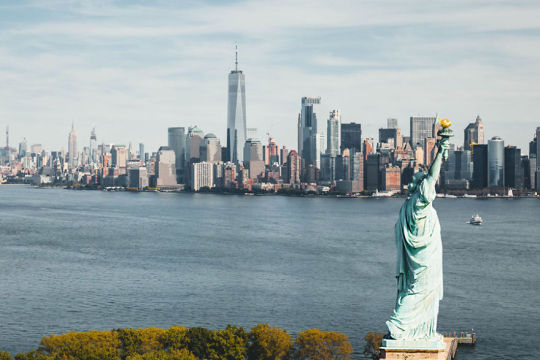


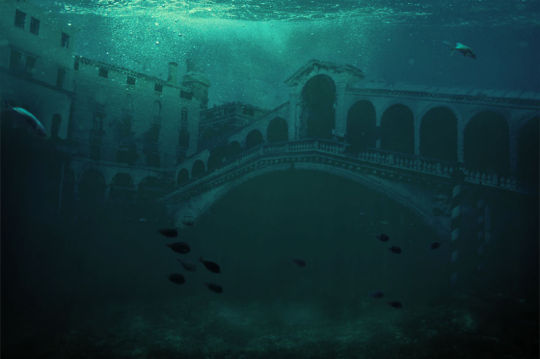





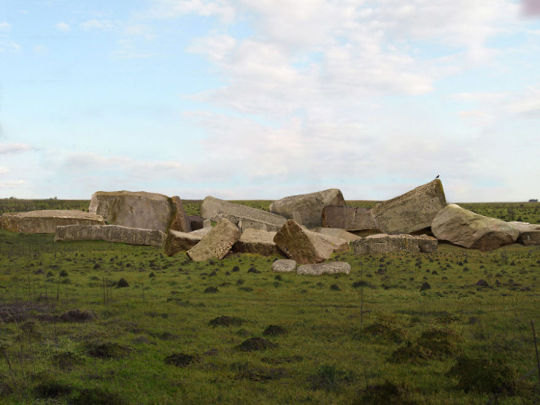
We Show What Famous Landmarks Will Look Like If Climate Change Isn’t Stopped (30 Pics) - Tom Mcloughlin
We have created a photo series showcasing the damaging effects that climate change will have on some of the world’s most loved tourist landmarks.
More info: thelatinamericatravelcompany.com | Facebook | Instagram | Twitter
Statue of Liberty, New York – Now
The sight we all associate with the USA. Visitors to NYC must see the Statue of Liberty. Statue of Liberty, New York – Future
Rising water levels will engulf cities around the world, leaving the 93m Statue of Liberty barely visible above the water.
Great Barrier Reef, Australia – Now
The beautiful Great Barrier Reef is a magical array of life and color, which water babies visiting Australia love to explore. Great Barrier Reef, Australia – Future
Warmer temperatures, ocean pollution, and coral bleaching will kill off all of the vibrant marine life that light up the Barrier Reef.
Amazon Rainforest, Brazil – Now
One of the most iconic places in the world, people flock to Brazil to marvel at the beauty of the Amazon Rainforest. Amazon Rainforest, Brazil – Future
Deforestation is already a huge threat to this natural landscape, and will eventually leave the area bare – killing off all of the wildlife that lives there. Antarctica – Now
Somewhat mystical Antarctica is known as a beautiful white landscape we all dream of exploring. Antarctica – Future
Rising temperatures will cause the ice to melt, leaving a bare landscape underneath. Rising sea levels could erase the country, leaving the animals who roam here with no way of survival. Parthenon, Greece – Now
One of the most iconic places in the world, the Parthenon still stands after thousands of years. Parthenon, Greece – Future
Carbon emissions, frequent tourism, and acid rain will cause this ancient structure to crumble. Venice, Italy – Now
One of the most romantic places in all of Italy, couples swoon over Venice’s charm. Venice, Italy – Future
The city is at high risk from frequent tourism, which is already causing damage, and as sea levels will continue to rise, the canal city could end up entirely underwater. Three Sisters, Australia – Now
Three Sisters is one of Australia’s top tourist attractions, boasting beautiful natural rock formation and incredible views. Three Sisters, Australia – Future
Rising temperatures and bush fires will ravage the landscape, leaving burnt landscapes and erasing all greenery. Pastoruri Glacier, Peru – Now
One of the most famous glaciers in the world, tourists to Peru marvel at the beauty of the ice structure. Pastoruri Glacier, Peru – Future
Our glaciers are already melting, and in the future, they are set to be nothing but rock. Stonehenge, UK – Now
One of the most mysterious landmarks in the world, Stonehenge is top of many travelers’ bucket lists. Stonehenge, UK – Future
The amazing landmark may be destroyed by moles causing soil erosion to the ground below. The mole population will increase due to rising temperatures. Mumbai, India – Now
One of India’s most popular cities to visit, the culturally-rich Mumbai is full of interesting landmarks to explore. Mumbai, India – Future
Overpopulation in Mumbai will lead to overcrowding, and poor living conditions as all free space will become utilized for poor quality housing. Victoria Falls, Zambia – Now
One of the most spectacular sights in the world, Victoria Falls is a site to behold. Victoria Falls, Zambia – Future
2019 gave us a scary glimpse into the future of Victoria Falls, and as temperatures continue to rise, droughts could cause the Falls to dry up forever.
https://www.boredpanda.com/now-future-landmarks-climate-change-tom-mcloughlin/?utm_source=google&utm_medium=organic&utm_campaign=organic
0 notes
Text

The world is facing a major crisis due to the excessive use of plastics. Every day, more than 200 million tons of plastic are produced globally. However, the alarming rate at which this material is being consumed has raised concerns about its environmental impact. According to a report by World Economic Forum, by 2050 the volume of plastics produced globally will be around twice that of today. This will have a detrimental impact on our planet, given the high level of degradation and toxicity of plastics. As per a study conducted by the University of New South Wales (UNSW), about 90% of seabirds and more than 40% of marine mammals have ingested plastic debris.
How Harmful is plastic to the environment?
Plastic has been a part of our lives for the last few decades. We have seen this versatile material is used in almost every sector, including healthcare, agriculture, construction, automobile, and food and beverage industries. However, there is a rising concern that excessive use of plastic is putting a serious threat to the environment. There are two major reasons behind this: First, plastic is not biodegradable, which means that it will remain in the environment indefinitely. This is because it takes hundreds of years to decompose and break down into small molecules that get absorbed into the soil and water bodies.
When the plastic gets accumulated in the environment, it leads to the formation of giant masses known as the “Great Pacific Ocean Garbage Patch”, which is one of the five oceanic gyres. These gyres are areas where plastic accumulates due to the absence of ocean currents. Second, plastic is derived from crude oil, which is a non-renewable resource. So, over time, the production of plastic will result in a significant amount of greenhouse gas emissions.
Toxic chemicals in plastic
Excessive use of plastic is a major worldwide concern, given the harmful effects, it can have on the environment. However, the choice between plastic and other alternatives like glass or paper is not as simple as it is often perceived to be. For example, in the packaging industry, many people consider paper to be their eco-friendly alternative to plastic. But, what they don't know is that paper also contains toxic chemicals such as dioxin and furan, which are carcinogenic. It is also harmful to aquatic life. To decrease its toxicity, the paper needs to be breached. However, the chemicals used for bleaching can also be harmful to the environment. Now let's look at plastic. It is also harmful, but it can be recycled, so its toxicity can be reduced.
Marine life at risk
It is not just land that is at risk of pollution, but the oceans as well. Plastic is damaging aquatic wildlife. In a recent study conducted, it was found that about 90% of seabirds and more than 40% of marine mammals have ingested plastic debris. It is estimated that plastic kills about 1 million seabirds and more than 100,000 marine mammals every year. There are several ways that marine life is negatively affected by plastic waste. Some animals, such as turtles, mistake plastic bags for jellyfish and other edible organisms. Sea birds are also at risk of ingesting plastic bags, mistaking them for fish eggs.
The road ahead
Now that we have understood the harmful effects of plastic, it is time to look for an eco-friendly and sustainable alternative. This can be done by using biodegradable and compostable packaging materials. This will eliminate the need to use plastic bags, which are often used for packaging products in grocery stores and supermarkets, as well as other retail stores. There are many eco-friendly alternatives to plastic that can be used in place of traditional plastics. Plant-based materials such as corn, wheat, bamboo, or hemp can be used for biodegradable packaging. Some other eco-friendly alternatives to plastic include glass, metal, or paper packaging.
So, what can be the eco-friendly alternative to plastic?
Biodegradable packaging is the best alternative to plastic packaging.
It is made from renewable resources such as corn and wheat. Some of its other advantages include the following: - Biodegradable packaging is not harmful to the environment, as it is made from natural organic materials. When it is exposed to water and sunlight, it gets broken down into small molecules that get absorbed by the soil. - It is cost-effective. Compared to plastic, biodegradable packaging is cheaper. - It is non-toxic. Biodegradable packaging does not contain any harmful chemicals.
Conclusion
The alarming rate at which the production of plastics is growing has raised concerns about its environmental impact. The world is facing a major crisis due to the excessive use of plastics. However, the rising concern about the harmful effects of plastic has prompted us to look for an eco-friendly alternative to it. Plant-based materials such as corn, wheat, bamboo, or hemp can be used for biodegradable packaging. Similarly, glass, metal, or paper packaging can also be used as an eco-friendly alternative to plastic.
0 notes
Text
Note for Tutor
Tumblr keeps glitching on me saying it hasn't uploaded somthing but I can't figure out what is missing so I have placed it all in my sketchbook as a backup.
10 Animals in danger due to climate change
Our planet is getting warmer, the threat to climate change is real, and our dependence on fossil fuels is the biggest contributor. Unless we make some radical changes, global temperatures will continue to rise and it will have severe consequences for humans and animals.
Amphibians such as frogs are vulnerable to desiccation and require moist conditions to reproduce. They are thus at risk from climate change. Decreasing water bodies in Yellowstone National Park, for example, is driving declines in the Columbia Spotted Frog population. Climate change is also causing the rapid spread of the deadly chytrid fungus Batrachochytrium Dendrobatidis, which is endangering amphibians worldwide.
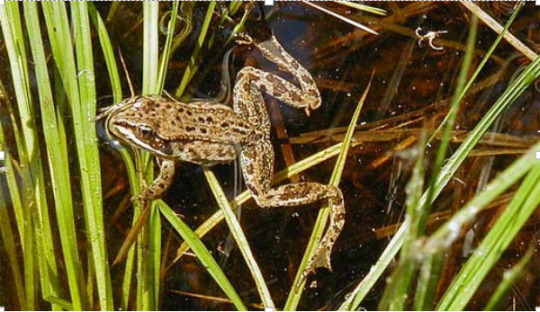
Staghorn Coral (Acropora Cevicornis) has experienced a population decline of over 80% since the 1970’s, mostly due to climate change. It is listed as Critically Endangered on The IUCN Red List of Threatened Species. Staghorn coral is particularly vulnerable to bleaching, whereby increasing water temperatures cause coral to expel the symbiotic algae that provide its nutrition. Coral reefs are some of the most biodiverse ecosystems on Earth – as ocean temperatures continue to rise, we also risk losing the countless species that depend on reefs for their survival, such as clownfish and hawksbill turtles.
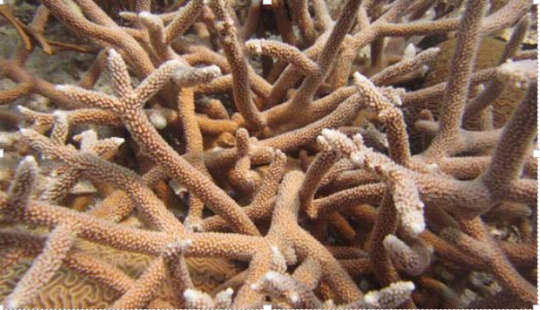
Close relatives of rabbits and hares, Pikas are adapted to cold alpine conditions and are very intolerant of high temperatures. The American Pika (Ochotona Princeps) has been retreating upslope to escape rising temperatures and it is feared the species will eventually have nowhere left to go. In some locations, American Pika populations have already entirely disappeared. Other Pika species native to Eastern Europe and Asia are facing the same dire fate.
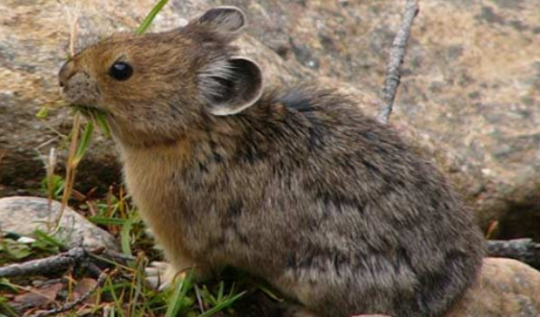
The Adélie Penguin (Pygoscelis Adeliae), a well-established resident of Antarctica, is facing tough times due to climate change. The birds are declining on the West Antarctic Peninsula, which is one of the most rapidly warming areas on Earth. The Adélie Penguin’s coastal nesting grounds are becoming increasingly unsuitable for chick survival, and sustained periods of warmer than usual ocean temperatures is negatively affecting the ability of prey such as fish and krill to survive.

The Leatherback Sea Turtle (Dermochelys Coriacea), weighing in at half a tonne, is a giant among reptiles. Like all marine turtles, Leatherbacks are threatened by bycatch, poaching and pollution. Climate change is an additional, rapidly emerging threat to marine turtles globally. Rising sea levels and extreme weather events wash nests away and decrease nesting habitat. In sea turtles, sand temperature determines the gender of developing young – warmer eggs turn into females, cooler eggs turn into males. Under global warming, turtle sex ratios are likely to become skewed, resulting in population decrease.
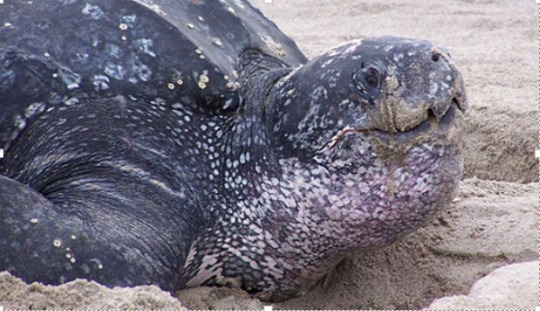
The Koala (Phascolarctos Cinereus), Australia’s most iconic fluffy marsupial, is likely to become rarer over the next century due to global warming. Koalas have an extremely specialised diet consisting only of eucalyptus leaves. Increasing carbon dioxide levels in the atmosphere are decreasing the nutritional value of leaves, resulting in Koala malnutrition and starvation. Longer and more frequent droughts will increase the occurrence of bushfires, which kill millions of forest-dwelling animals like Koalas. Koalas will also increasingly be forced to descend from trees in search of water and new habitats during dry conditions, exposing them to predators and road traffic.

A popular food fish, Atlantic Cod (Gadus Morhua) has been the victim of decades of disastrous overfishing. While the implementation of fishing quotas helped stocks to recover, recent rapid ocean warming has severely impacted cod spawning and survival, causing populations to plummet again. It is thought that warmer waters decrease the availability of zooplankton critical to juvenile fish survival and development. Moreover, to escape the high temperatures, young fish are likely to venture into deep water where they at greater risk of predation.

Beautiful Monarch Butterflies (Danaus Plexippus) are famous for their impressive migrations across North America to reach southern overwintering grounds. Like all butterflies, the Monarch is very sensitive to weather and climate. Increased frequency of extreme weather events is threatening the future of this charismatic species. Furthermore, Monarch caterpillars eat only milkweed – as the climate continues to warm, the butterfly’s range is becoming drier, resulting in loss of vital food plants.

Ringed Seals (Pusa Hispida), polar bears’ favourite prey, are highly dependent on Arctic sea ice and almost never come onto land. Warming spring temperatures and early sea ice breakup are causing nursing pups to be prematurely separated from their mothers. Additionally, warmer ocean temperatures are likely to boost seal parasite populations and the forced migration of seals to more stable ice habitats will facilitate the spread of disease.
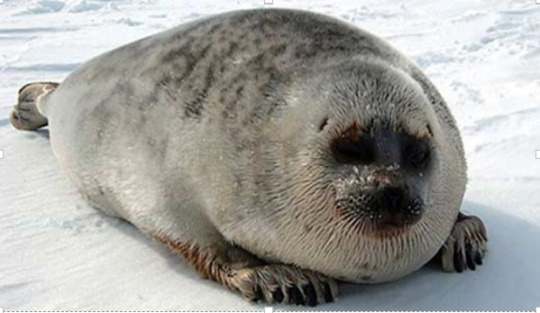
The majestic Polar Bear (Ursus Maritimus), a flagship for climate change awareness, is facing an uncertain future due to dwindling sea ice in its Arctic habitat. Longer, warmer summers are causing much of the Arctic Ocean to be ice-free for extended periods of time, decreasing the bears’ access to their primary prey – seals. Consequently, the bears are forced to spend more time foraging on land, where they are at risk of coming into conflict with humans.
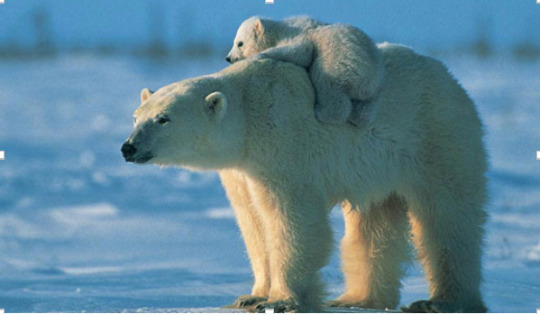
2 notes
·
View notes
Text
- Erasure - 1

Hwang Hyunjin x Female Reader
With washed out, dyed pastel hair, sea salt and acrylic clinging to his jeans, Hwang Hyunjin expected to find himself many places that night. A jail holding cell. Under the abandoned train station bridge. Maybe even his own bedroom.
Your living room wasn't on the list.
Warnings - Some angst in later chapters, suggestive/smut, minor character death mentions, Hyunjin is an eboy and a little angsty, Changbin is doing his best as a big brother, slow burn (?)
A/N - Finally! Sorry for the delays, my head just hasn’t been with me this week;; I hope you enjoy this series as much as I am excited to write it.
***
The steady buzzing of your speakers fills the living room as you watched Changbin scroll through the Netflix home page. Both of you settle deep into the sofa, balancing a bowl of popcorn and chocolate between your knees.
“Endgame? Homecoming, Nightmare on Elm Street?” Binnie flicks through the suggestions, and you shake your head in distaste. “I'm not watching that octopus documentary again!”
“You only hated it because you cried at the end.”
“She died! He had to look after her little babies! Your heart is too cold, too far gone for that level of compassion.” The last part of your brother's grumbles are cut off when you throw a burnt kernel at his forehead, barely missing his ear.
There’s nobody else home. Nobody else ever comes home, either. It's been just you and Changbin for a while, and it's not all that terrible. He’s a few years older than you, having graduated last summer and now undertaking an apprenticeship at the village police station. It doesn't pay a stellar amount, but Changbin reassures you once he passes the trainee exams he’ll treat you to a new pair of winter boots and you can finally quit the ice cream parlour to focus on college. You tell him that even if he wins the lottery tomorrow, you'll work your own job. For all the support your elder brother gives you, you like having your own thing. It makes you feel a little more involved, a little more even than jsit washing the dishes and doing his laundry on days he’s too tired to move.
The Thursday evening is reserved for you both, to catch up on the hours together you miss during the week when Changbin doesn't get back till you're fast asleep and you don't have the chance to say good morning.
He’s been doing that a lot more recently.
Sighing into his coffee, shaking his head at nobody in particular. It's easy to notice the signs of stress and overwork in his face, sunken and tired even on the weekends when he finishes early.
“Do you wanna finish Teen Wolf?” The softness in his voice when he addresses you is the same, though. “We have three episodes left of this season, if you wanna binge.”
“Sure.” You want to ask him about the circles under his eyes. What’s got him coming home later and later because nothing ever happens in this town. “I'm still waiting on Derek’s redemption arc.”
You're twenty minutes into the episode when a vibration from your coffee table catches your attention. You glance at Changbin, but he ignores his ringtone, flipping it to silent.
It rings again, no music, but harsh vibrations drumming against the polished wood.
And again.
Knowing he’s not picking up to make a point of it, you pause the show, nodding at the mobile he’s avoiding glancing at. “Go on. Pick up, it might be an emergency.”
“If it's an emergency they don't need an intern there.” Despite his words, Changbin shifts his position and you know he’s growing hesitant.
“If it's an emergency all the more reason for you to be there and learn.” You state with more force behind your tone. “Why have your grades been dropping? You're coming home so late but your exams keep getting delayed -”
“My grades are fine!” Changbin never snaps at you, but the frustration in his voice is evident. “I'm fine. There's just - Just one case we're working on and I'm nearly there, I just need time.”
You shut your mouth, letting him speak.
“There’s this kid who keeps tagging the beach houses on Dawning Lane, and that shit was expensive to put up last year. Some stupid, bored child that thinks a few cans of spraypaint and lung cancer are a good excuse for your adolescence. He’s not even that good… Just scribbles.”
His lips pout in a frustrated whine at the last phrase, and you know he’s more frustrated at the situation than he is at you or himself.
A beat of silence, interrupted by another ringtone - you almost reach for it yourself to check the caller ID and force him to pick up, before Changbin’s arm shoots out past you to snatch the device, slinking out the door and into the hallway.
You aren't surprised when a few moments later, your brother’s head pokes nervously out the door frame - He's already got his coat on, waving his phone at you as an awkward goodbye.
“I’ll see you in the morning, y/n.”
“Yeah, see ya.” You salute back, smiling to ease the tension in his shoulders, and it works a minimum. You won’t see him till the late evening at best.
The door clicks shut as soon as he turns around, leaving you surrounded by popcorn and empty space. You really aren't surprised - but it'd be pointless to deny you weren't hurt by another night alone with Teen Wolf playing idly through your TV speakers. Cold popcorn only did so much to soothe your heart, and the distance wedging itself recently between your sibling bond was hard to brush over, between missed calls and texts too often left unanswered.
You just really miss your big brother.
You commit yourself to Stiles Stilinsky instead, sighing into the blanket around your shoulders. Autumn rolls in quick by the seaside, making your calves prickle with goosebumps. It's nearing 11pm, you realise, picking up the -
Thump!
Your fingers freeze, hovering over the TV remote. Changbin wouldn’t be back yet, he never comes home the same night he leaves.
“Bin?” You try it anyway, calling tentatively into the hallway. It’s still entirely black, void of disruption.
Clang!
That definitely came from your kitchen.
Armed with a half empty popcorn bowl and nerves of steel, you tiptoe into the other room. There’s a lump of something or someone crouched behind the dining table, and your grip around the glass dish tightens marginally despite the quivering of your knees, fumbling for the lightswitch without taking your eyes off the rising dark mass as it straightens its back.
“S-Stay down! I have corn and I know how to use it!” You don’t have a fully formed plan yet, but you’re sure the sharp kernels will be of some importance. Fluorescent white light floods the kitchen, momentarily blinding both you and the intruder who now stands at full height. A steady 12 inches above you.
“Ouch! Calm down, I’m not going to rob you!” He says, sounding almost exasperated at your defense of your own property. He still has his hands raised in defense, keeping the table between himself and you, and you’re grateful he hasn’t tried to knock your legs out from under you, yet. “I’m not here to steal your stuff.”
“What are you here for, then?” You lower the popcorn bowl, but don’t let it fall out of your grasp. He doesn’t seem dangerous - He doesn’t seem like he could manage clambering through the window you always leave ajar either, but here he clearly is. There’s something sticky and pink in his blonde hair, stains following down his shoulder blades all the way down the cuffs of his jeans. If anything, he looks...a little lost.
“It’s the address on the post-it note.” Your confusion must have been plainly obvious, because the boy elaborates, pulling a crumpled neon-green paper from his jacket. “The post-it note that man gave me. That’s what Changbin gave me.”
Perhaps you lack self preservation instincts, but there’s an uncertain vibration in his voice that makes you give up your weapon and attitude.
“You know my brother?”
“He told me if I really need to go somewhere, I can come here.” You watch slim fingers tug at the sleeves of his jacket as he measures with a weight akin to a glare. “He didn’t tell me it was his house, or that somebody else was living here.”
Bold of him to accuse you of ruining his night plans.
It really did only click in your head when you looked closer at his tangled hair, dried paint clumping it together at the ends of bleached blonde strands. The artistic menace haunting your sea-side town was standing right on your tiled kitchen floor, and he looked downright miserable.
And Changbin had invited him.
Biting down the discomfort at realising how little Changbin had been telling you recently, you set the popcorn down on the table, you take in the threat currently three feet before you. A tall, lanky boy, with odd shoelaces and a sharpie sticking out of his trouser pocket. His hair hasn’t been cut in a while, and probably brushed either - it’d be generous to say he ran more than a stressed hand through it anytime recently. Though chapped, his full lips and wide eyes made him look far too innocent for his own good, and you blamed your soft heart for finding the boy kinda cute.
He did have a leaf stuck above his ear, though.
You almost reached up to remove it.
“Do you wanna watch Teen Wolf?” You break the quiet that settled, already shuffling your feet out into the living room. You sincerely hoped he’d follow. You weren’t sure what you could do apart from leaving him standing on cold tile, and he already looked freezing from the night chill.
Luckily for you, with a hesitant step, your impromptu companion takes after you to the couch where your Netflix and remove still await instruction. Changbin might grumble at you tomorrow at finishing the season without him, but you needed something to lure the boy into comfort.
“I’m y/n, by the way.” You mention. The boy sits stiffly, clasping his hands in his lap with parted lips, avoiding the decorative pillows.
“Hyunjin.” Now that he’s actually inside your house, Hyunjin’s confidence seems to have evaporated. The thrill of the break-in, if you can even call is that, has worn off, giving way to the nerves. He’s suddenly too conscious of the paint on his clothes, of sandy shoes still on his feet, of the smudges still on his cheeks. Should he take his jacket off? Or wipe his shoes?
You press resume, watching him relax after a few minutes as his brain finally has something else to focus on to let his worries ease. Hyunjin doesn't seem to mind you already being halfway through the episode, and you let yourself admit it’s nice having someone around this late at night.
“How do you know Changbin?” You ask while the topic is still fresh.
“I don’t.” Hyunjin bumps his knees together, fiddling with a loose string on his jeans as he shrugs. “I don’t really know him, he just...saw me around a few times, and I guess he figured I could use a place to crash. So he gave me your address.”
“You’re the mystery kid painting the beach houses, right? On Dawning Lane.”
At the accusation, Hyunjin’s lips part, flipping to face you with wide, blinking eyes., knowing he’s in no place to try and deny it. You blink back, observing his reactions, in case he suddenly changes his mind about staying. “Are you gonna turn me in?...”
“No.” You shake your head after a moment of thought, and he visibly untenses. “For whatever reason Changbin didn’t, so I won’t either. If he trusts you then I do too.”
You’ll never know if it was the murmurs of the TV, or if Hyunjin did whisper a thank you, and you won’t ask. There’s a lot of things you do want to ask, but a tug in your heart tells you now is not the time. Hyunjin looks exhausted, eyes drooping with every slow blink as he does his best to focus on the screen, hands previously tugging at his jeans now still and flat on his lap, slouched forward as if any moment he’ll drift off sitting on your pillows. Flurries of fluorescent light flicker on his cheeks, over barely scrubbed paint smudges and faint cuts from running too fast, you guess. In the delicate, dimmed light of your floor lamp, it’s hard to imagine Hyunjin as a bad kid. Prickly, maybe. On edge is a better word for it, tension clinging to his shoulders like stubborn dust bunnies. Curse your naive little heart, you tell yourself, building up your courage to speak.
“Hyunjin?” He hums in response, straightening his back. “Do you want to sleep here tonight?”
All you’ve been taught in life sent alarm bells through your skull when you asked a complete stranger (who just two hours ago, broke in through your kitchen window) to sleep in your living room overnight, but Hyunjin didn’t feel like a stranger. Changbin trusted him enough to lead him right to your house, so that must count for something, right? And no matter how much you tried to keep your guard up around the boy, watching him struggle to stay upright instead of letting his tall, lanky body fall backward and rest comfortably only made you worry a little about him, not the other way around.
Well, he did say he’s not going to rob you.
“You can sleep on the couch if you want, I’ll bring you some blankets.” You prompt him again when he doesn’t respond. “Changbin won’t be back for a while still.”
“Are you sure you’re okay with that?” There’s a lilt of doubt in his voice, but he sincerely hopes you’re serious. This couch is warmer than anything he’s slept on in months and he really doesn’t want to crawl outside again with the rain pattering against your roof.
“Sure, you haven’t tried to stab me yet.” You shrug, getting up to fetch a duvet and looking him over.
“Ah, you probably want to wash your hair from all...that,” Hyunjin’s hand flies to his hair, patting out the tangles as if it’s the first time he’s noticed them. “You can use the bathroom upstairs, there’s towels by the shower already.”
He nods, following your directions with a ‘thank you’. Once his footsteps disappear up the landing, you set about pulling out the couch into a flatbed, rearranging the pillows at its base. Lugging the duvet down from Changbin’s room had been a feat, but you’re determined to make the space welcoming. Satisfied with the cushioned bundle you created, you run back upstairs.
You invade your brother’s room for the second time that day, tugging open his drawers in search for something acceptably pijama-like.
“Hyunjin?” You knock tentatively on the bathroom door as the shower head turns off and the shuffling ceases. “I’m leaving some clothes for you to change into outside, okay? Come downstairs when you’re ready.”
You scroll through your timeline as you wait, catching up on the last few hours’ events from your friends until a shuffling to your left prompts you to raise your head.
Your brother’s sweats hang a little loosely around Hyunjin’s hips, ending just above his ankles, bare feet sliding over the wooden floor of your living room, sinking into the rug as he steps closer to where you sit. His own clothing cradled in his arms close to his chest, you can’t stop your thoughts drifting momentarily to the damp mess of sunshine coloured hair. With his jacket on earlier, it was hard to make out his build under layers of fabric, but now it’s proving a challenge to not focus on the lines of his arms or the curves of his large hands gripping his clothes. Luckily for your dignity, your nerves of steel allow you to drag your gaze away from the collarbones peeking out from under thin white cotton higher to meet his eyes instead and find your voice again.
“I brought down some pillows for you, these are a bit too hard to sleep on.” You note, pointing to the decorative cushions you moved onto the lounge chair. “My room is right opposite the bathroom if you need anything, I’m a light sleeper.”
“M’okay.” Hyunjin towers above you, yet you’ve never seen a boy so dainty. There really is no other way to describe the delicate line of his nose bridge or the rosy tint of his lips when his tongue pokes out to lick them as he mulls over your words, settling down on the makeshift bed.
The proximity now feels different than the air between you when Teen Wolf still blared through your speakers, warm quiet heavy on your tongue with dim golden glow tumbling over his cheekbones that’s too much for your heart to take unprepared.
“Goodnight then!” You bounce up from the couch waving Hyunjin a quick goodbye, but a soft hand wrapping around your wrist pauses you.
“Wait,” Hyunjin brushes his thumb over your palm softly, and you hope he doesn't notice the goosebumps on your skin at the contact. “Thanks for not kicking me out...or calling the police. Y’know, as most people would for a break in.”
The smile he flashes you is almost teasing, but you can tell he means the words sincerely. You lay your other hand on top of his, patting in what you hope is a reassuring motion.
“Sure, Jinnie. It’s okay.”
#skz fluff#hyunjin fluff#hyunjin scenario#hwang hyunjin#hyunjin smut#stray kids#stray kids fluff#stray kids imagine#hyunjin erasure#hyunjin angst#stray kids imagines#changbin fluff
54 notes
·
View notes
Link
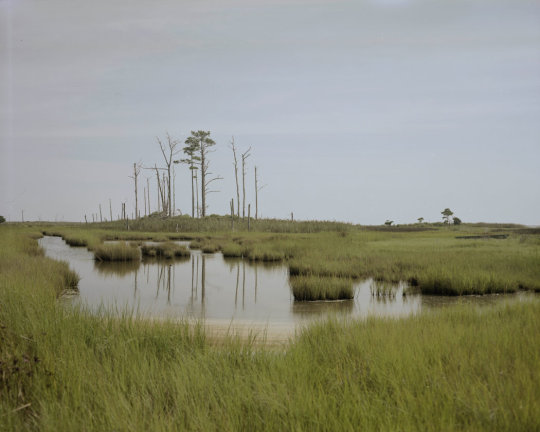
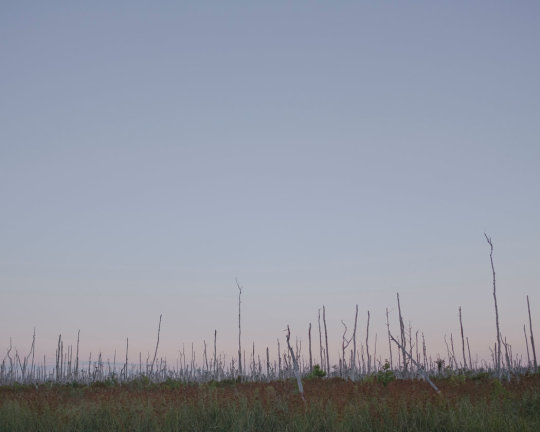
Excerpt from this New York Times story:
Up and down the mid-Atlantic coast, sea levels are rising rapidly, creating stands of dead trees — often bleached, sometimes blackened — known as ghost forests.
The water is gaining as much as 5 millimeters per year in some places, well above the global average of 3.1 millimeters, driven by profound environmental shifts that include climate change.
Increasingly powerful storms, a consequence of a warming world, push seawater inland. More intense dry spells reduce freshwater flowing outward. Adding to the peril, in some places the land is naturally sinking.
All of this allows seawater to claim new territory, killing trees from the roots up.
Rising seas often conjure the threat to faraway, low-lying nations or island-states. But to understand the immediate consequences of some of the most rapid sea-level rise anywhere in the world, stand among the scraggly, dying pines of Dorchester County along the Maryland coast.
Part of the reason for the quickly rising waters may be that the Gulf Stream, which flows northward up the coast, is slowing down as meltwater from Greenland inhibits its flow. That is causing what some scientists describe as a pileup of water along the East Coast, elevating sea levels locally.
The effects of climate change are also exacerbated by land that is sinking as a result of geological processes triggered by the end of the last ice age.
Because of the extraordinary speed at which the water is rising here, Dr. Gedan said, “I think of this area as a window into the future for the rest of the world.”
As saltwater moves into the ground, oak and other sensitive hardwoods die first. Loblolly pine, the most salt-tolerant, is often the last tree standing until it, too, is overwhelmed.
Then the saltwater marsh plants move in. If you’re lucky, velvety tufts of cordgrass sprout. If not, impenetrable stands of cane-like Phragmites, an invasive species, take over.
403 notes
·
View notes
Text
The GREAT Barrier Reef!
The most incredible thing about nature is a daunting question to answer since nature is so vast and complex, but one thing that has always fascinated me is the Great Barrier Reef. Located in the Coral Sea off the coast of Australia, the Great Barrier Reef is the largest marine landform in the world, the perimeter is about 2300km (“Great Barrier Reef | Geography, Ecology, Threats, & Facts | Britannica,” 2021) which is as long as 207 professional football fields! Despite covering just a small portion of the Earth’s surface, coral reefs are crucial for atmospheric and oceanic chemistry, which make them important mediators of the effects of climate change, and of course in terms of global biodiversity; did you know that coral reefs are home to at least 30 animal phyla? Most other surface habitats on earth host less than 20 (Birkeland, 2015)!

The Great Barrier Reef is home to approximately 300 species of coral along with other unique marine species like anemones and sponges, and the more common sea creatures like crabs, lobsters, and fish, of course, many in amazingly bright colours, unlike the fish we are used to seeing in the Canadian Great Lakes (“Great Barrier Reef | Geography, Ecology, Threats, & Facts | Britannica,” 2021)! One creature, in particular, has been incredibly damaging to the reef systems. Can you guess the culprit? Hint: it isn't humans...this time. If you guessed that a starfish may be to blame, you got it, specifically the crown-of-thorns starfish. This sea star even looks menacing with all its spines that cover its body which is made up of anywhere from 10-20 arms (“Crown-of-thorns starfish | echinoderm | Britannica,” 2021)! The meal of choice for these creatures is living coral, and in conjunction with a decline in natural starfish predators, like large sea snails, populations of the crown-of-thorns starfish are booming, threatening the lush corals of the Great Barrier Reef (“Crown-of-thorns starfish | echinoderm | Britannica,” 2021). This invasive species is just one of many obstacles threatening the health and longevity of the Great Barrier Reef.
Coral bleaching is one of the biggest threats to the Great Barrier Reef, and this time humanity shoulders some of the responsibility for this because of the relationship with climate change. The reason I bring humans into this equation is because of the reasons for the warming waters. As we continue to pollute the atmosphere with greenhouse gases, the ambient carbon dioxide levels rise along with atmospheric temperatures (Haerri, 2020). With warmer air comes warmer surface water temperatures, and corals are very sensitive to temperature fluctuations. When the water temperatures rise above the tolerable threshold for these colourful algae that live within the coral, they evacuate their habitats leaving corals vacant and bleached (Haerri, 2020). The problem arising when the algae disappear is the result of the symbiotic relationship that exists between coral and its algae. Corals are not heterotrophs so they cannot synthesize nutrients for themselves, seemingly problematic for an immobile creature, but enter algae, specifically unicellular dinoflagellates which can undergo photosynthesis, providing energy for themselves and the corals in which they live (Haerri, 2020).

Ecotourism: a mitigation strategy for human-based impacts on the Great Barrier Reef!
Aside from the obvious beauty and wonder provided by the Great Barrier Reef, why is it important to protect this particular landscape in a world with seemingly larger problems to work out, most obviously the problem of the COVID-19 pandemic. Well, not only are coral reefs the source of 25% of marine biodiversity (Haerri, 2020) making them one of the most important ecosystems in the world but they have immense power to regulate ocean chemistry and are a source of income and goods for millions of people in the world (Birkeland, 2015). A great solution for the issue of climate change and coral bleaching as well as the overall health of the Great Barrier Reef is through the involvement of ecotourism with a focus on eco-efficiency initiatives (Zeppel, 2012). It is well known that tourists will pay for proper interpretation be it through safari trips, city walking tours, or any other method where an expert shares their knowledge about a particular topic unfamiliar to the tourists (Beck et al., 2019). In recent years, Australian tourism operators have begun offering climate change workshops to improve the knowledge held by marine tourism industry workers so they can better advocate for the wellness of marine ecosystems that are suffering and share that with visitors (Zeppel, 2012). I think this is a fantastic avenue to ensure people who are visiting a landscape of such wonder truly appreciate all that it has endured. Additionally, it can serve to show tourists how they might make a difference in their own lives to prevent further deterioration of this ecosystem and others just as important and beautiful that are scattered across the earth.
References:
Beck, L., Cable, T. T., & Knudson, D. M. (2019). Interpreting cultural and natural heritage: For a better world. Urbana: Sagamore Publishing
Birkeland, C. (2015). Coral Reefs in the Anthropocene. Coral Reefs in the Anthropocene, 1–15. https://doi.org/10.1007/978-94-017-7249-5_1
Crown-of-thorns starfish | echinoderm | Britannica. (2021). In Encyclopædia Britannica. https://www.britannica.com/animal/crown-of-thorns-starfish
Great Barrier Reef | Geography, Ecology, Threats, & Facts | Britannica. (2021). In Encyclopædia Britannica. https://www.britannica.com/place/Great-Barrier-Reef
Haerri, S. (2020). Unit 7: Climate Change Biology: Coral Bleaching. Lecture Notes Retrieved, March 18, 2021
Zeppel, H. (2012). Climate change and tourism in the Great Barrier Reef Marine Park. Current Issues in Tourism, 15(3), 287–292. https://doi.org/10.1080/13683500.2011.556247
2 notes
·
View notes
Text
Massive, unrivalled deep-sea project just discovered a bunch of new Atlantic species
https://sciencespies.com/nature/massive-unrivalled-deep-sea-project-just-discovered-a-bunch-of-new-atlantic-species/
Massive, unrivalled deep-sea project just discovered a bunch of new Atlantic species

It’s taken nearly five years, 45 research expeditions, and more than 80 scientists and students, but the largest oceanic research enterprise, the ATLAS project, is officially complete.
Exploring 12 locations in the deep northern Atlantic, the project has set a gold standard for future marine research.
Driving underwater robots to areas never before explored, researchers have uncovered a dozen newly identified species, including fish, cold-water coral and other invertebrate sponge species. Not to mention the discovery of 35 known species in previously unknown areas.
Already, the results have produced 113 peer-reviewed papers, with 98 more soon to follow.
Among the new findings is a type of coral growth, known as Epizoanthus martinsae, which thrives on black corals over 400 metres deep (1,300 feet).
Other discoveries include a type of sedentary animal resembling moss, called Microporella funbio, which was found in an undersea mud volcano off the coast of Spain.
Another moss-like animal, named Antropora gemarita, was also found filtering and feeding particles of food drifting in the deep sea.
The project and its findings are unrivalled and speak to how much the deep ocean still has to offer. Yet without healthy, deep-sea ecosystems, these newly discovered species will no doubt struggle to survive.
“As the birthplace of deep-sea biology and the cradle of oceanography, the North Atlantic is the place we should know best,” says Murray Roberts, the ATLAS coordinator, “but only in the last 20 years have we uncovered how varied and vulnerable its deep-sea habitats really are.”
In fact, scientists today say we know more about the surface of the Moon and Mars than we do of the deep Atlantic, and that’s a serious problem.

Cold water corals and seastars. (French Research Institute for Exploitation of the Sea)
Sponges and corals may not seem like important animal species in the grand scheme of things, but in the deep sea they form the foundation for most ecosystems.
Marine biologists actually refer to them as the ‘cities’ of the deep, providing food and shelter for many more types of fish.
In a rapidly changing world, however, these remote ecosystems appear particularly vulnerable to human activity.
Despite their name, black corals are not always black, and while they do not bleach with high temperatures like shallower corals, climate change is still their biggest threat.
Given their propensity for growing in the deep, we still have very little information about these corals’ conservation status, which means they could go extinct before we even find them. The same goes for any deep sea species they support.

Black coral and crabs (University of Edinburgh)
“If those cities are damaged by destructive human uses, those fish have nowhere to spawn and the function of those whole ecosystems is lost for future generations,” Roberts told the BBC.
Oceans absorb up to a third of the carbon in our atmosphere, and research from the ATLAS project suggests half of all cold-water coral habitats are at risk from warming temperatures.
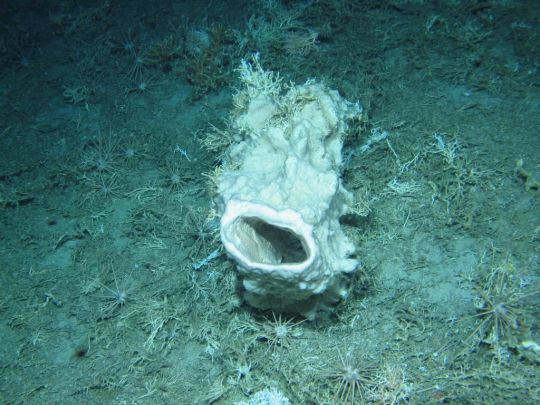
Sponge and sea urchins. (University of Edinburgh)
Nor is that the only threat faced by these deep sea communities. The ATLAS project found ocean acidification and fishing could also place nearly 20 percent of deep water ecosystems at high risk.
Acidification is one of the most disastrous outcomes for corals, corroding the skeleton of these reefs almost like osteoporosis in humans.
“That’s attacking the very foundations of huge deep-sea coral reefs,” Roberts explained to ABC News Australia.
“Predictions are showing the suitability of the habitats really collapsing over the next 100 years.”
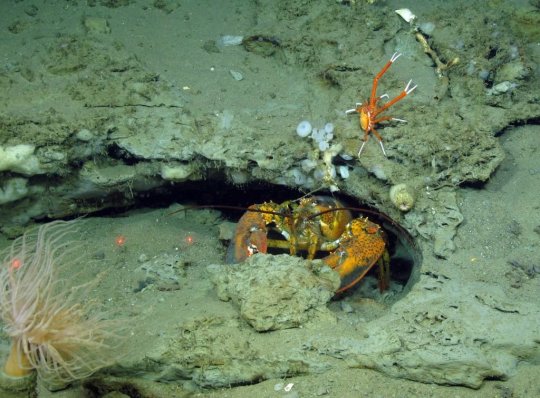
American lobster and squat lobster at Baltimore Canyon. (Steve Ross)
Even the major currents of the Atlantic are slowing with climate change, and this means the warm, salty water usually carried to the north is taking longer to cool and sink, possibly causing sea levels to rise or changing global weather patterns. It could also impact the resources deep sea ecosystems are able to access.
“Everyone knows how important it is to look after tropical rainforests and other precious habitats on land, but few realise there are just as many, if not more, special places in the ocean,” says Roberts.
“In ATLAS we’ve studied most vulnerable ecosystems in the deep Atlantic and we now understand how important, interconnected and fragile they really are.”

Lophelia pertusa, a cold water coral. (Solvin Zankl Geomar)
The massive project might be done for now, but it continues to serve as a model for other marine scientists.
Researchers in South America are already preparing to undertake a similar project in the southern Atlantic ocean, which is far less explored, and exploration is set to finish in 2023.
Who knows what treasures of the deep we’ll find this time.
#Nature
1 note
·
View note
Text
Another grim climate report on oceans – what will it take to address the compounding problems?
by Cassandra Brooks

The U.N.‘s climate panel report released Sept. 25 makes crystal clear that the planet’s oceans, snow and ice are in dire trouble and the damage is causing harm to the people who depend on them. Even with aggressive efforts to lower greenhouse gas emissions, many nations will struggle to adapt.
All people on Earth depend on the ocean and cryosphere – the frozen regions of our planet. Together they provide vital services to humanity including food, fresh water and energy. But they also perform critical services, including the uptake and redistribution of carbon dioxide and heat.
Yet, the Intergovernmental Panel on Climate Change Special Report on the Ocean and Cryosphere says human-induced climate change is harming the health and function of the ocean and cryosphere in a number of ways. Glaciers and ice sheets are shrinking. Global sea level is rising at more than twice the rate of the 20th century. The ocean is warming, becoming more acidic and losing oxygen. Fifty percent of coastal wetlands have been lost over the last 100 years. Species are shifting, biodiversity is declining and ecosystems are losing their integrity and function. The strain on the ocean and cryosphere has direct and indirect effects, threatening human health, food security, fresh water and livelihoods.
Same trends, new urgency
As a marine scientist and environmental policy scholar who’s worked in the Antarctic for the last 15 years, I wonder if any of this is really news. Earlier this week, the World Meteorological Organization reported similar findings: that the last five-year period has been the warmest on record, ice mass is decreasing, sea level is rising and CO2 emissions are at an all-time high.
Earlier this year, the world’s leading natural scientists released the Intergovernmental Science-Policy Platform on Biodiversity and Ecosystem Services report which confirmed that biodiversity and ecosystem functions and services are deteriorating across the world. Last year the IPCC released a special report on the impacts of global warming of 1.5 degrees Celsius above pre-industrial levels with similarly dire predictions.

UN Intergovernmental Panel on Climate Change, CC BY
There are more details in this latest IPCC report on changes that have occurred in the past few decades. Since 1993, the rate of warming has likely more than doubled; the ocean has already soaked up between 20% and 30% of human-induced carbon emissions since the 1980s, altering the ocean water chemistry to make it more acidic; and marine heat waves have resulted in large-scale coral bleaching, which takes more than 15 years for corals to recover from.
The report notes that communities that live in close connection with coastal environments, small island nations, polar areas and high mountains are particularly vulnerable to changes, such as rising sea levels and shrinking glaciers. But communities in other areas are affected by ocean changes as well, such as through extreme weather events exacerbated by ocean warming.
This most recent report on the ocean and cryosphere is among dozens released during the last 30 years by the IPCC, but its message is the most bold and urgent to date: If the world’s nations do not act with urgency, we – and future generations – will suffer from these changes.
What can we do?
A relatively straightforward solution to curbing biodiversity loss, especially in the face of climate change, is expanding the global network of large-scale protected areas on land and ocean.
While highlighted by the report, the importance of this management practice is also old news. Protected areas have been implemented for years to conserve marine ecosystems, and are now being implemented across the world. Studies continue to show that strict protected areas, which limit or prohibit human use, safeguard biodiversity while also enhancing resilience to environmental impacts, including climate change. Indeed, high-profile initiatives like E.O. Wilson’s Half-Earth Project argue that people must protect at least half of the planet to ensure human survival.
But protected areas are not enough. The report also highlights an even more challenging, yet crucial, component of the solution: Rapid reduction of greenhouse gas emissions must be achieved across institutional boundaries. The global nature of the issue demands a globally coordinated effort toward ambitious cuts in emissions.
The United Nations Climate Action Summit, which convened over the weekend of Sept. 22, intended to do just this. The goal of the meeting was to identify realistic plans toward reducing greenhouse gas emissions by 45% during the next decade and further to net-zero by 2050. Seventy-seven countries announced efforts toward net-zero emissions by 2050. Multiple businesses voiced intentions to follow Paris Agreement targets to reduce emissions.
Widespread climate strikes, led largely by young people, are also a sign of a broader social response to climate change.
But is this enough to stop the degradation of our ocean, cryosphere and larger Earth system?
History shows that communities do change and that crisis can drive breakthroughs. On an international scale, the world witnessed this with the Montreal Protocol, which banned a class of gases called CFCs and halted the deterioration of the ozone hole, driven in part by fear of cancer and other human health issues. Another international victory was achieved when, in the face of potential discord, including a threat of nuclear war, global governments signed the Antarctic Treaty. Doing so transformed the southern continent from a burgeoning scene of militarization to an international commons dedicated to peace and science.
While ecological tipping points have proved impossible to predict, I believe a social one is arriving. The new IPCC Special Report on the Ocean and Cryosphere makes clear that no action on climate change is not a viable path forward.

About The Author:
Cassandra Brooks is Assistant Professor Environmental Studies at the University of Colorado Boulder
This article is republished from our content partners over at The Conversation under a Creative Commons license.
28 notes
·
View notes
Text
Cancer causing Foods you are eating every day
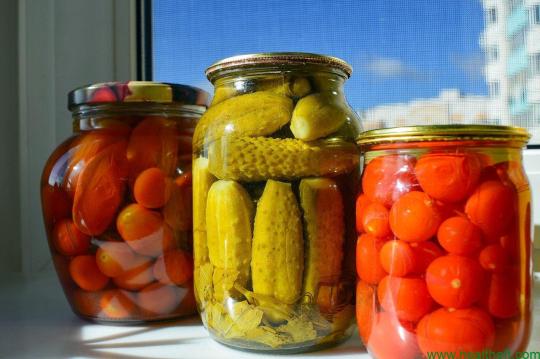
It’s in all probability not one thing you consider day by day, however the meals you might be consuming would possibly trigger most cancers! Yes, you learn that proper! Cancer is a type of ailments that loom over a very good majority of the inhabitants. Avoiding these 13 meals altogether, and even limiting your consumption of them, will help cut back your possibilities of contracting most cancers.
1. Foods That Are Highly Salted, Pickled, Or Smoked
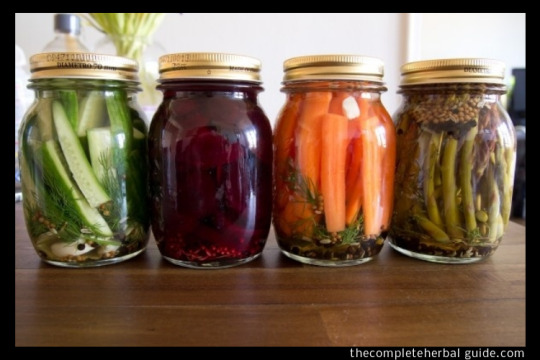
Meats reminiscent of bacon, sausage, bologna, and salami are excessive in fats and salt. Pickled meals are very excessive in salts. Eating a majority of these meals vastly will increase the danger of colorectal most cancers and better charges of abdomen most cancers.
2. Diet Anything

Diet meals, together with frozen meals, or prepackaged meals labeled as “diet” or “low-fat”, together with weight loss plan sodas, usually include aspartame, which is a chemical, synthetic sweetener. There are quite a few research exhibiting that aspartame causes many ailments and sicknesses reminiscent of cancers, delivery defects, and coronary heart issues.

3. Microwave Popcorn

Conventional microwave popcorn baggage are lined with a chemical known as perfluorooctanoic acid ( PFOA). This is a toxin you'll find in Teflon additionally. According to a latest examine on the University of California, PFOA is linked to infertility in ladies.
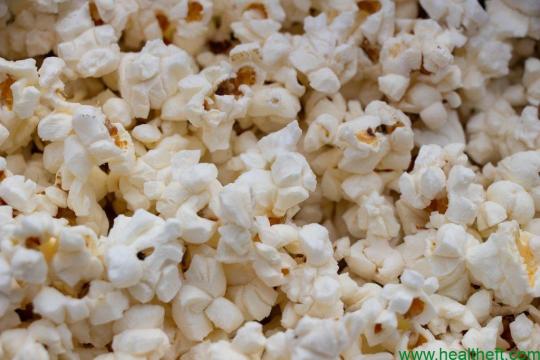
4. Non-Organic Fruits

Fruits which are non-organic are contaminated with some very harmful pesticides reminiscent of atrazine, thiodicarb, and organophosphates, in addition to excessive nitrogen fertilizers. Atrazine is banned in European nations however nonetheless used right here. This is a weed killer that causes extreme issues in people, particularly in our reproductive capabilities.

5. Packaged Potato Chips

Packaged potato chips are excessive in each fats and energy, that are certain to carry on weight achieve. A examine performed in the New England Journal of drugs discovered that consuming simply 1 ounce of potato chips per day prompted a mean 2-pound weight achieve in a single 12 months. Besides being filled with trans-fats which may trigger excessive ldl cholesterol in most individuals, they've extreme sodium ranges which, for many individuals, trigger hypertension.
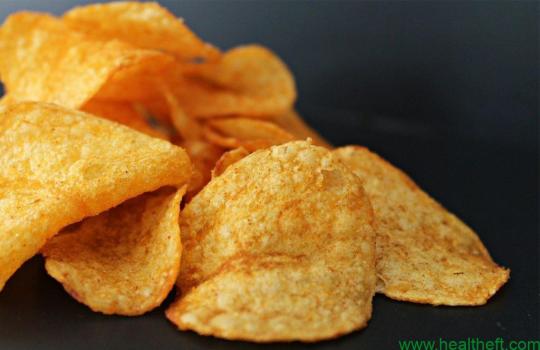
6. Alcohol

Alcohol use is the second main explanation for most cancers, proper behind tobacco use. While average or low consumption of alcohol will be wholesome and result in a diminished threat of coronary heart illness, extreme ingesting is understood to trigger coronary heart failure, stroke, and sudden demise.

7. Canned Tomatoes
The lining of just about all canned meals is made with a chemical known as bisphenol-A, or BPA. Tomatoes are exceptionally harmful because of their excessive acidity, which appears to cause BPA to leech from the liner of the can into the tomatoes themselves.
8. Processed Meats
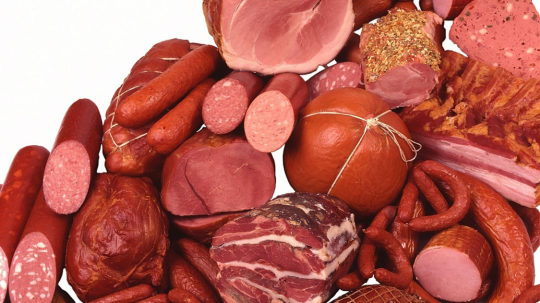
Meat Delicacies, Ham, Sausage, Salami, Hot canines, Small sausages
All these processed meats include quite a few chemical substances and preservatives, together with sodium nitrates, which make them, look interesting and contemporary however are well-known carcinogens. Smoking meats appear to be significantly dangerous because the meat picks up tar from the smoking course of. Yes, tar, the identical lethal ingredient that cigarette smoke accommodates.
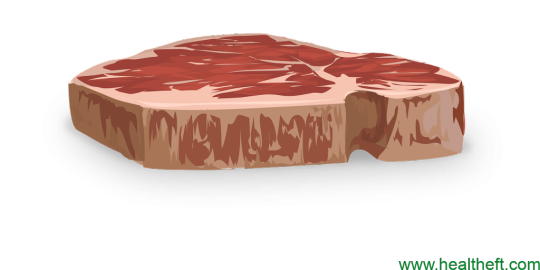
9. Farmed Salmon
These fish are fed unnatural diets and are contaminated with chemical substances, antibiotics, pesticides, and different recognized carcinogens. They dwell in very crowded situations which leads to these fish having 30 instances the variety of sea lice than wild salmon. Farmed salmon are fed chemical substances to make their meat that reddish pink colour that ought to happen naturally however doesn’t due to the weight loss plan of hen litter that they're fed.
10. Artificial Sweeteners

There is mounting proof that the chemical substances that make up these sweeteners, particularly aspartame, break down within the physique right into a lethal toxin known as DKP. When your abdomen processes this chemical, it, in flip, produces chemical substances that may trigger most cancers, particularly mind tumors.
11. Hydrogenated Oils
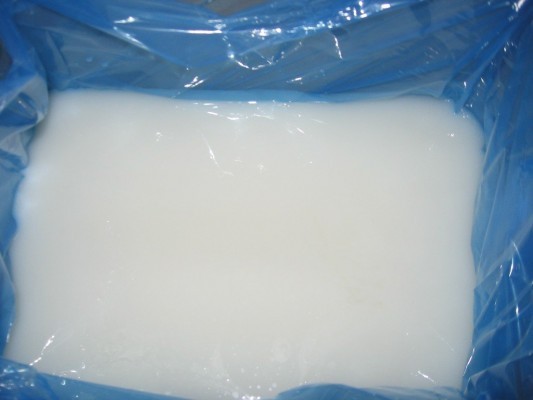
Processed meals are actually dangerous for you, this we in all probability all know already. However, it's what's within the processed meals that's the downside for most individuals. These hydrogenated oils are generally used to protect processed meals and to maintain them secure whereas being caught on a shelf for lengthy durations of time. These oils have a tendency to change the construction and integrity of cell membranes throughout the human physique, which tends to steer in the direction of ailments reminiscent of most cancers. Some producers are working to take away the utilization of hydrogenated oils and substitute them with palm oil or one other secure different. Trans fat are nonetheless broadly used, sadly. Vegetable oils are likely to include excessive ranges of Omega-6 fatty acids, of which extra could cause well being issues. A steadiness have to be fashioned between Omega Three and Omega 6 for a nutritious diet. Supplements and grass-fed meats ought to do the trick to steadiness oils out.
12. White Flours
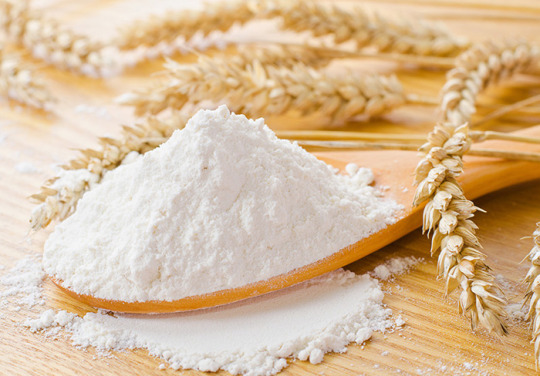
Refined white flour is a typical ingredient throughout the majority of processed meals. The extra carbohydrate content material throughout the flour is the principle trigger for concern, nonetheless. A examine printed within the journal Cancer Epidemiology, Mile Markers, and Prevention found that refined carbohydrates have been linked to a 220 % enhance in breast most cancers amongst ladies. Rapid rises in blood sugar ranges all through the physique, which gasoline most cancers cell development and unfold, have been additionally found inside high-glycemic meals typically. The mills that bleach this flour have a tendency to make use of a chemical referred to as chlorine fuel, which is a harmful irritant that's unsafe to inhale and will be deadly in massive portions. Cancerous tumors feed on sugars throughout the bloodstream, so avoiding refined grains can starve a tumor fully. Find more healthy choices at your local retailer if it is advisable to get your palms on flour. Choosing flour that has not been bleached white is the most suitable choice you'll be able to select, too.

13. French Fries

French fries, very similar to potato chips, have excessive ranges of acrylamide, a carcinogenic substance that kinds inside meals at excessive temperatures, similar to when they're baked or fried. Studies have proven this substance will enhance the danger of quite a few several types of most cancers inside the human physique. The International Agency for Research on Cancer has stated that acrylamide is a possible human carcinogen. Food heated to a temperature above 242 levels Fahrenheit usually, has ranges of the substance inside them. However, French fries are likely to include one of many highest ranges amongst meals examined by the Research company. More analysis is required to find out the precise info, however it's recognized to trigger types of most cancers throughout the host. Limiting the variety of French fries you eat or discovering a more healthy different total, is the most suitable choice when trying to keep away from the expansion or unfold of cancerous cells within the physique.

If you like our articles ,please share with your friends.
Also read:
Natural Remedies and Treatments for Cancer
Read the full article
1 note
·
View note
Text
Coral!!!
Coral reefs are the breeding grounds for thousands of marine species. Without them, we would lose many of our colorful sea species that we have come to love. Sadly, we might have to start imagining a world without them. As much as 27 percent of monitored reef formations have been lost and as much as 32 percent are at risk of being lost within the next 32 years.
This is due to a natural process called coral bleaching. Coral bleaching occurs when a coral is exposed to a change in environment where the coral expels its algae, causing it to turn completely white, where the coral becomes extremely vulnerable to disease and starvation. Environmental changes that can cause this are an increase in temperature, over exposure to air or sunlight, and pollution/runoff.
These bleachings have occured all over the world. Mass bleaching is most common and most severe in shallow communities, however it is not restricted to the shallows. Major occurrences have been recorded to depths of over 25 metres on the Great Barrier Reef and 30 metres on Scott Reef off Western Australia. In 2005, the U.S. lost half of its coral reefs in the Caribbean in one year due to a massive bleaching event. Bleaching events also tend to follow the path of El Nino.
It might not seem like that much of an issue but it can have pretty dramatic effects. It can inhibit coral growth, disrupts reproductive rates (slows recovery of the coral), increased disease outbreaks, loss of habitat, decrease in coral reliant populations, species extinctions, areas become vulnerable to invasive species, loss of pharmaceutical compounds, and islander cultures can be affected.
Global warming is the biggest threat to corals. The rising of temperatures causes coral bleaching. Corals are extremely sensitive, so even a change of 1 degree celsius could cause a colony to bleach. The increase of temperatures has also caused ocean acidification which has lowered the pH levels of ocean causing the growth rates to decrease and also lessened the structural integrity of the corals. Sadly, this is more of a job of solutions for the professionals. But, today I have tips to help you keep from contributing to the destruction of coral reefs around you!
1.Support reef-friendly businesses
2. Buy organic food and avoid using fertilizers
3. Volunteer for a reef clean-up
4. Support conservation organizations
5. Self educate
6. Spread the word!
7. Don’t litter/pollute!
8. Recycle
9. Conserve water
10. Don’t start a rock/shell collection (I know it’s pretty but the ocean needs it more than you do)
11.Don’t touch the coral if you snorkel
12. If riding a boat, don’t anchor in the reef
Thank you everyone for reading today! So, to close up below I am going to be showing some pictures of coral reefs that are victims to bleaching.



4 notes
·
View notes
Text
4/05- How Food Production Degrades Aquatic Biodiversity
This week, we read Chapter 11 of Living in the Environment by G. Tyler Miller and Scott E. Spoolman, which focused on the ways humans threaten aquatic biodiversity and how we can restore and protect aquatic ecosystems. We also read Chapter 12 of Living in the Environment, which discussed our current methods of food production and ways to make them more sustainable. I have noticed that these two topics are very related. Three of the biggest threats to aquatic biodiversity are the pollution of oceans, soil erosion, and unsustainable fishing, and these are all exacerbated by unsustainable food production practices.
The pollution of the world’s oceans caused by human activity is a major threat to aquatic species and their ecosystems. Since 80% of the global population lives near seacoasts, lots of human trash, either dumped from garbage barges or left as litter near the coast, ends up in the ocean (Miller and Spoolman 237). This trash threatens aquatic biodiversity because it kills as many as a million seabirds and a hundred thousand aquatic mammals every year, since these species often eat bits of plastic trash that look like fish or other food (Miller and Spoolman 237). Figure 1 below shows the killer plastic debris found in the stomach of a dead Albatross seabird.

Figure 1 (Chris Jordan Photographic Arts).
The dumping of plastic into the ocean is related to unsustainable food production practices because one of the main ways plastic is used is for food packaging and distribution. Therefore, one way to protect aquatic biodiversity would be to reduce our use of plastic in food packaging and in general, as well as to recycle our plastic instead of dumping it into the ocean.
Oceans and other aquatic ecosystems may also become polluted by soil erosion that can carry toxic pesticides or excess plant nutrients from land into nearby water supplies. Pesticides can kill fish and plant nutrients can cause algae populations to flourish (Miller and Spoolman 274, 237). This leads to an increased use of oxygen by the decomposers that break down dead algae, depriving other marine species of the oxygen they need to survive (Miller and Spoolman 237).
Soil erosion also releases carbon dioxide into the atmosphere, which causes climate change, ocean warming, and ocean acidification (Miller and Spoolman 274). Firstly, climate change and atmospheric warming melts ice, which disrupts species habitats in Arctic and Antarctic areas. Melting ice also causes sea levels to rise, which can potentially destroy coral reefs, swamps, islands, and coastal wetlands, which are all full of biodiversity (Miller and Spoolman 239). Then, since oceans absorb carbon dioxide and 90% of the excess heat in the atmosphere, increased atmospheric carbon from soil erosion contributes to the warming and the acidification of the world’s oceans (Miller and Spoolman 238). Warmer and more acidic oceans cause coral bleaching and the degradation of coral reefs, which are important habitats for many marine species (Miller and Spoolman 234). Because of all of these reasons, soil erosion is a big threat to aquatic biodiversity.
One way to reduce harmful soil erosion is to use more sustainable farming methods. Soil erosion is not only a threat to aquatic biodiversity, but also our ability to successfully grow crops because topsoil purifies water and provides nutrients necessary for plant growth (Miller and Spoolman 273). So, preventing soil erosion is of utmost importance. Of the many sustainable farming methods proposed by Miller and Spoolman in Chapter 12, I think the best method for reducing soil erosion is to use no-till farming. If I worked for a farmer and was in charge of deciding whether to switch to no-till agriculture or to continue using conventional plowing methods, I would choose the no-till method. Although no-till agriculture may be more costly in the short-term because it would require special planting equipment, it would be more profitable in the long run because it would reduce soil erosion. No till farming reduces soil erosion because the land is left uncleared and new crops are planted on top of scraps from last season's crops, instead of the land being plowed for fresh soil (Miller and Spoolman 261). This makes sure that no topsoil is left bare and exposed to potential erosion from water and wind (Miller and Spoolman 286). Other sustainable methods for reducing soil erosion include terracing and contour planting, which reduce the ability of water to flow down sloped land and erode soil. Additionally, creating windbreaks, or surrounding crop fields with trees, provide shelter to crop fields and prevent wind from eroding the soil (Miller and Spoolman 286). However, most industrialized agriculture relies on soil tilling and leaves the soil bare and vulnerable to erosion when it is not growing season, and this ends up harming aquatic biodiversity (Miller and Spoolman 273).

Figure 2. Topsoil erosion at an industrialized farm (Miller and Spoolman 273).
Food production is also harmful to aquatic biodiversity when it comes to farming and harvesting fish. Trawler fishing boats that drag huge fishing nets over the ocean floor disrupt ocean habitats and threaten marine species (Miller and Spoolman 236). Fisheries also often overfish certain species and do not consider the effects this may have on other marine species populations (Miller and Spoolman 249). To combat this, we should rely on more sustainable methods of producing seafood, like aquacultures. Aquacultures are fish farms which raise fish in lakes, ponds, reservoirs, or underwater oceanic cages (Miller and Spoolman 270). These are especially effective at reducing biodiversity because they raise plant-eating fish, like catfish and tilapia, which reduces the reliance on unsustainable fishmeal that is fed to popular carnivorous fish like salmon and shrimp (Miller and Spoolman 249). However, aquaculture does have some disadvantages, like the large amounts of land that can be required to sustain them (Miller and Spoolman 280). Other advantages and disadvantages of aquaculture are listed in Figure 3 below.

Figure 3 (Miller and Spoolman 280).
Because food production causes plastic pollution, soil erosion, and overfishing, it contributes to the degradation of aquatic biodiversity and ecosystem services. This unfortunately means that protecting aquatic biodiversity depends on the ability of one of the largest industries in the world to prioritize sustainability. Not only would prioritizing sustainability have a large upfront cost, it would require change to an already well established industry. Can we convince the leaders of the food production industry to sacrifice profit and enact change to protect aquatic biodiversity?
Word count: 1045
Works Cited
Chris Jordan Photographic Arts. “Chris Jordan’s ALBATROSS film trailer.” May 22, 2017. Educational video, 1:18. https://vimeo.com/218502282.
Miller, G. Tyler and Scott E. Spoolman. Living in the Environment. 20th ed. Boston: Cengage Learning, Inc., 2021.
0 notes